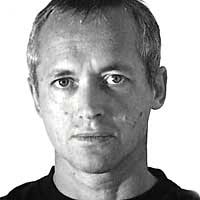|
Georg Vith
|
Waiting for pictures |
||
|
Biography Born in 1959 in Schruns, Austria 1980-1985 studies at Akademie of fine arts in vienna (Prof. Maximilian Melcher and Edelbert Köb) 1985 award from austrian federal departement of science and research since 1986 several prices and purchases in different competitions Personal exhibitions and projects with camera obscura (selection) 2004 Bahnhof Andelsbuch Inari Kultahovi, Inari, Finland National Museum of Stockholm, Sweden KHG Graz, Austria 2003 Museum of perception, Graz, Austria Artmuseum Liechtenstein, Vaduz, Liechtenstein Palm Tree, Montserrat, Westindies, United Kingdom Via Cairoli, Florence, Italy Boat view, Mälardrottningen, Stockholm, Sweden Burren College of Art, Ballyvaughan, Ireland Viewbox 03, Turun Kristillinen Opisto, Turku, Finland 2002 Out of focus, Art university of lapland, Rovaniemi, Finland Caprice des dieux, Albert Borschette Centre, Brussels, Belgium Zimmer 22, Silvrettahaus, Bielerhöhe, Austria 2001 Nähe-Ferne, Klaus, Austria Archive 2000, ABF-Mikroverfilmung, Feldkirch, Austria Inside-Outside, Chios, Greece Edmund Kalb, Schillerstraße 22, Dornbirn, Austria Inside-outside, Art university of lapland, Rovaniemi, Finland 2000 Dialog der Dinge, Studio Drehpunkt, Bregenz, Austria Die Originalität des Gewohnten, Gallery of Künstlerhaus, Klagenfurt, Austria 1999 42x68 68x68 im k&k, St. Johann, Carinthia, Austria 1998 Project inside-outside, Silvretta, Austria 1996 & co, Theater am Saumarkt, Feldkirch, Austria 1995 Zeichnungen, Salvator Gallery, Graz, Austria Kartografie des Unscheinbaren, Bildungshaus Batschuns, Austria Participations (selection) 2004 Deutsch-Russisches Begegnungszentrum, St. Petersburg, Russia ICH, Transformerhaus, Bregenz, Austria 2003 V. I. G., Graz, Austria Druckgrafik, Pässler und Schlachter, Lauterach, Austria 30 Jahre Palais Liechtenstein, Feldkirch, Austria La Tentation, Schloss Amberg, Feldkirch, Austria 2002 KunstVorarlberg, Palais Liechtenstein, Feldkirch, Austria 2001 Kunstraum, Dornbirn, Austria 2000 Palais Thurn & Taxis, Bregenz, Austria 1999 Kunstforum Montafon, Schruns, Austria Silvrettatelier, Siechenhaus, Bregenz, Austria 1998 Spiel mit den Wirklichkeiten, Saumarkttheater, Feldkirch Palais Thurn & Taxis, Bregenz, Austria 1997 17. Internationale Malerwoche, Suetschach, Carinthia, Austria Bildungshaus Batschuns, Austria 1996 Tenneale Nenzing, Austria Kunst im Millenium, 9 Künstler aus 9 Bundesländern, Neuhofen an der Krems, Upper Austria 6 Künstler aus Vorarlberg, Ragenhaus, Bruneck, Italy 1995-1984 numerous exhibitions in Innsbruck, Bozen (I), Vienna, Nenzing, Klagenfurt, Lienz, Bregenz, Feldkirch
|
|
The eye is not a camera but an instrument very slowly registering everything, an instrument the work of which is satisfied with things gone before and things to come. Work, which in itself has a strange time, structure and is taking place in a certain time. (B. Busch). The cameras you can walk inside of which are part of Vith’s work of perception since 1998 appear as the same slow instrument. Their work of finding pictures simply takes time. A completely darkened room, which only permits, punctured light to come in combines after longer waiting different levels of visibility. It creates from at first almost invisible positions a network of visible fragments. The interior and exterior world form a connection, open up questions for the viewer and therefore create a level of being. The visitor of such a camera is invited to initially wait for ten to fifteen minutes in order to take in the slowly appearing picture. And only then to realise how very slowly an upside down picture of the exterior is coming down to the interior. The room and also the blank eye are being captured by a gradually forming picture, which creates a direct relationship to the surroundings. The skin like picture which has covered the interior changes itself gradually but ongoing through the movements of the sun and therefore through the incidence of light. Glances move along these changes, capture stories about the inside and outside in the form of dialogues. But the glances also move over the interior of the viewer, the camera creates a new horizon of reason. (G. Anders). The rooms offer a broad scope of discovery and tell stories in different forms, determined by time, place and situation, the viewer develops into a discoverer of his own perception. The continued incompleteness is a state of work because an extreme focus of the pictures is only roughly possible: the smaller the hole through which the rays of light can enter the sharper the picture appears to the viewer. At the same time it becomes weaker and disappears. A bigger opening allows more light to come in and the picture becomes blurred. The principle of the camera is the sign of the New Time, of the central perspective discovered in the Quattrocento, which constituted a change of pattern of society. David Hockney describes the growing mechanization of the sensory perception starting in the 15th century in a relevant book. He talks about many painters who at that time started using optical means such as mirrors, lenses or a combination of both. With those they produced true to life projections of pictures in order to create paintings or pictures. This new process of capturing the world in pictures spread out quickly and changed the view of reality. (D. Hockney) The principle of sharpness and blurredness can also be found in the works, which the artist creates by using his drawing cameras, which he built himself. The casing of the camera obscura is a device placed between the perception and its projects like a messenger of a sensory experience. At the same time the smooth surface of the ordinary becomes broken, the blurredness of our perception falls back on us – we puzzle insecurely over which abstract object faces us in the sketches and withstands our stereotyped views. The drawings in credit card format are cartographies of the inconspicuous and interrupt the daily routine the already too long pause in our thinking. (R. Tiefenthaler). Georg Vith
|
|


